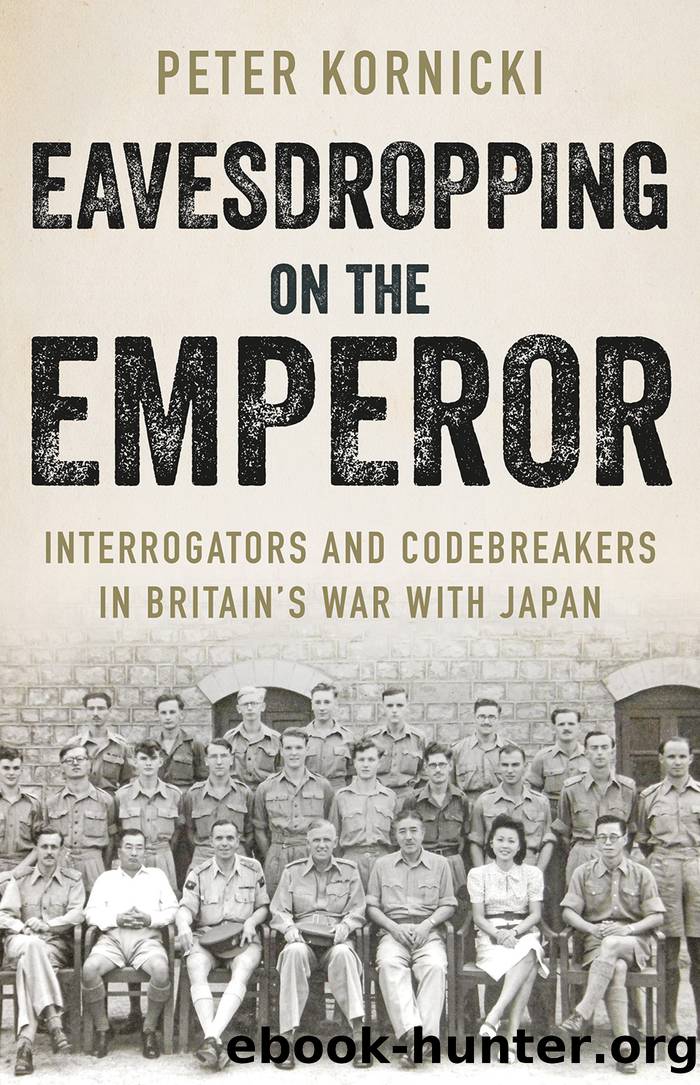Eavesdropping on the Emperor by Peter Kornicki

Author:Peter Kornicki [Kornicki, Peter]
Language: eng
Format: epub
Published: 2021-07-15T00:00:00+00:00
Japanese at Boulder
In June 1942, the teachers and students at Berkeley, including Keene, were uprooted and sent to Boulder, a little way north of Denver in Colorado. Why Boulder? For one thing, it was far enough away from the west coast to be safe from any of the anticipated Japanese coastal raids; what is more, Boulder was a small town, and the school would attract less attention there. Perhaps the most important consideration, however, was that in Colorado there would be no problem about enrolling Nisei as teachers, for Nisei were not barred from living there.
The US Navy Japanese Language School became a very efficient operation once it had settled in its new location, and by the end of the war it had trained over 1,000 Japanese linguists. Unlike the US Army Language School, Nisei were not admitted as students, but as many as 150 Nisei were released from internment to teach at Boulder, for the students were divided into small classes and there were several courses running at the same time. There were no fixed criteria for the recruitment of students, but at first a large number of those who were accepted for the school had some connection with Japan already, and many of them had grown up in Japan as the children of missionariesâthey formed a pool of students of a kind that was unavailable in Britain. Later on, when there were no more such students left, it was enough to be able to show evidence of linguistic gifts or academic excellence to gain admission. Most of the recruits were destined for the Navy, but some joined the Marine Corps, and, from 1943 onwards, ninety women from the US Navy Womenâs Reserve (known as WAVES, Women Accepted for Voluntary Emergency Service) were taught there too, albeit in separate classes.23
There can be no doubt that Boulder was a very successful operation, and, just as at Bedford, the outcome was down to one person. The courses were run by Florence Walne (1895â1946), a professor at the University of California, who had been born and raised in Japan and had taught there from 1916 to 1931. As Hindmarsh later acknowledged, âshe alone among the University teachers of Japanese in the summer of 1941, recognized the urgency, the practicability and the feasibility of doing the kind of job which eventually was done so well and to the tremendous advantage of the United Statesâ effort in the Pacific Areaâ.24
The courses Walne ran were highly competitive and demanding. They were taught both by repatriated missionaries and by large numbers of Nisei, including some who still had Japanese citizenship and were therefore technically enemy aliens. The ready availability of Nisei teachers gave the Boulder courses an advantage over the SOAS courses when it came to providing instruction in spoken Japanese, and the commitment of the Nisei was warmly appreciated by the students. Nevertheless, the reception accorded the Nisei and their families in Boulder was sometimes far from welcoming. What is more, the parents of some of the students were appalled that their children were being taught by âJapaneseâ.
Download
This site does not store any files on its server. We only index and link to content provided by other sites. Please contact the content providers to delete copyright contents if any and email us, we'll remove relevant links or contents immediately.
The Radium Girls by Kate Moore(11651)
100 Deadly Skills by Clint Emerson(4711)
The Templars by Dan Jones(4563)
Rise and Kill First by Ronen Bergman(4558)
The Doomsday Machine by Daniel Ellsberg(4262)
The Rape of Nanking by Iris Chang(4032)
Killing England by Bill O'Reilly(3903)
Hitler in Los Angeles by Steven J. Ross(3810)
Stalin by Stephen Kotkin(3733)
12 Strong by Doug Stanton(3426)
Hitler's Monsters by Eric Kurlander(3179)
Blood and Sand by Alex Von Tunzelmann(3072)
Darkest Hour by Anthony McCarten(3022)
The Code Book by Simon Singh(2883)
The Art of War Visualized by Jessica Hagy(2847)
Hitler's Flying Saucers: A Guide to German Flying Discs of the Second World War by Stevens Henry(2634)
Babylon's Ark by Lawrence Anthony(2447)
The Second World Wars by Victor Davis Hanson(2429)
Tobruk by Peter Fitzsimons(2384)
